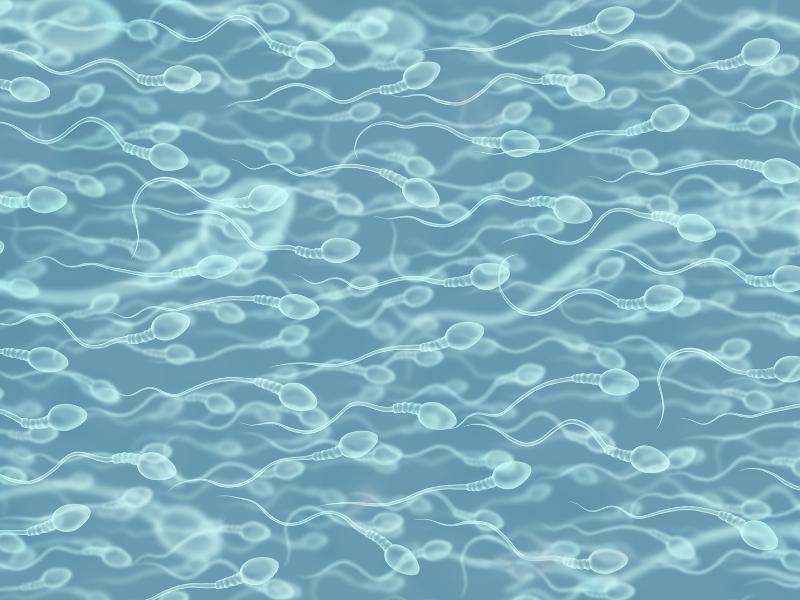Male factor infertility represents 35% of all infertility cases and the diagnosis is made by the presence of abnormal parameters on a semen analysis. A semen analysis has four main parameters, which include the volume 1.0-5.0 mL), count (≥ 20 million/mL), motility (active/forward moving sperm ≥50%) and morphology (normal appearance ≥14% by Kruger’s criteria and >30% by the old WHO criteria). Male infertility can be divided into three major categories that include: abnormalities of sperm production, abnormalities of sperm function, and obstruction or absence of the ductal system. Unfortunately, majority of male factor infertility is idiopathic (cause unknown).
Abnormalities of the sperm production can be due to testicular failure (Y chromosome microdeletions or Klinefelter’s syndrome), damage to the testes, toxins, radiation, infections, insufficient hormone production from the pituitary gland (FSH and LH) and use of androgenic compounds such as testosterone. Abnormalities of sperm function can be due to an infection of the genital tract (prostatitis), varicocele (an enlargement of the veins in the scrotum), anti-sperm antibodies, failure of sperm to attain fertilization potential ( commonly known as the ‘acrosome reaction’) and failure of sperm to bind and penetrate the egg. Obstruction of the ductal system includes prior vasectomy, blockage of the ejaculatory or epididymal ducts and absence of the vas deference from birth.
A semen analysis should be done after 2-5 days of abstinence. If abnormal, it should be repeated for confirmation of the abnormal parameters and in the absence of sperm (azoospermia), urological evaluation is recommended. Semen analysis provides quantitative information about the sperm, and in some men with normal semen analysis, quality of the sperm may still be compromised.
A recently developed test called the sperm DNA integrity assay (SDIA) or sperm chromatin structure assay (SCSA) has been used to diagnose those cases of possibly unidentified male infertility with normal semen analysis. SDIA is a helpful tool for measuring clinically important properties of sperm nuclear chromatin integrity. There are two components to this test, including the DNA Fragmentation Index (DFI) and high DNA stainability (HDS). Less than 15% of fragmentation and stainability are considered normal for either component and levels above 30-40% have been reported to rarely result in a live birth. SDIA has been shown to predict infertility and poor reproductive performance as it measures DNA damage. The DNA damage analysis may reveal a hidden abnormality of sperm DNA in infertile men classified as unexplained based on apparently normal standard sperm parameters.
If a man has a low sperm count, an endocrine evaluation is recommended. Hormones that are typically tested include FSH, LH, estradiol, testosterone, prolactin and TSH levels. Any abnormality in the levels of these hormones requires further assessment and patients are commonly referred to an urologist who specializes in male infertility for further work up and management. Genetic evaluation of men with low sperm count is also recommended after an initial evaluation to rule out any obstruction in the male genital system. Once an obstructive cause is ruled out in a patient with less than 5 million sperm per milliliter, a full chromosome analysis and testing for the Y chromosome microdeletions is warranted.
Although most men with abnormal semen parameters have a normal workup and the cause is unknown, some may have hormonal abnormalities for which medical treatment may be beneficial. One of these endocrinological disorders presents with low FSH, LH and testosterone levels suggesting that the gland in the brain called the pituitary gland is not releasing FSH and LH hormones that are necessary for sperm production. This is a condition called hypogonadotropic hypogonadism and such cases can be treated with clomiphene citrate to increase the production of LH, GnRH administration, gonadotropins, and HCG. In men with elevated levels of prolactin, a magnetic resonance imaging (MRI) of the brain is necessary to rule out a tumor. These cases are typically treated with medications called bromocriptine or cabergoline. In men with thyroid abnormalities, thyroid function is normalized with medications and reproductive hormones are also expected to improve with adequate sperm production. Testicular failure may be diagnosed by elevated levels of FSH and/or LH along with low levels of testosterone. Medical or surgical treatment is generally not successful and donor sperm is often times utilized to achieve a pregnancy. Alternatively, sperm can be obtained from the testicles by a biopsy and used in conjunction with an IVF and ICSI (intracytoplasmic sperm injection) procedure, although if there is no sperm found at the time of the biopsy, donor sperm becomes the only option.
Varicocele (dilation of the veins in the scrotum) can be associated with male infertility and poor semen parameters. In the general population, the prevalence of varicocele is approximately 15% (and about 40% in infertile men). Varicocele repair is indicated in men with large varicoceles that are apparent on physical examination with abnormal semen parameters who also desire fertility. Semen quality generally improves with surgical treatment especially in cases of large varicoceles, but the results achieved with varicocele repair vary greatly and significant evidence for improved fertility is still lacking. Other treatment options for men include intrauterine inseminations (IUI), IVF with or without ICSI.
In vitro fertilization (IVF) along with intracytoplasmic sperm injection (ICSI) offers the best treatment option for all male factor infertility cases regardless of the severity, but should not suggest that all male factor infertility cases be treated with IVF. In mild forms, IUI treatment is acceptable especially in early infertility cases with no other identifiable cause. This is a relatively inexpensive treatment method for mild cases, but it is not beneficial in cases of moderate to severe male factor.
When sperm cannot be collected through ejaculation or there are few or no viable sperm, a variety of sperm retrieval techniques can be used to obtain sperm for IVF/ICSI. Microsurgical epididymal sperm aspiration (MESA) and testicular sperm extraction (TESE) are procedures involving the introduction of a thin needle directly into the epididymis or the testicle under anesthesia to obtain sperm for IVF/ICSI procedure. Sperm are extracted from the tissue and each egg is injected with a single sperm using the ICSI technique. It is most commonly utilized in cases of spermatic duct occlusion or absence, but can also be performed in cases of ejaculatory dysfunction, such as spinal cord injuries, after prostatectomy or in cases of intractable male impotency. TESE or MESA is simple, relatively low-cost and offers fast recovery.
Contact: Appt or Ask Questions at 303-794-0045 or Email Us on our Contact Us page


